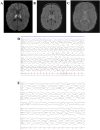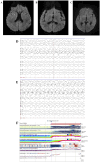Case Report: long-term clinical outcomes in RANBP2-associated acute necrotizing encephalopathy
- PMID: 40538544
- PMCID: PMC12176811
- DOI: 10.3389/fphar.2025.1607682
Case Report: long-term clinical outcomes in RANBP2-associated acute necrotizing encephalopathy
Abstract
Introduction: Acute necrotizing encephalopathy (ANE) is a rare and severe neurological condition primarily affecting children and commonly triggered by viral infections. Morbidity and mortality rates are high. Pathogenic RAN-Binding Protein-2 (RANBP2) variants predispose children to recurrent ANE, known as ANE1, and increase the risk of severe outcomes and early death. Although the pathophysiology of ANE is not fully understood, an inflammation-mediated "cytokine storm" is believed to play a crucial role in central nervous system involvement. Currently, there is no guidance on the optimal duration of immunotherapy.
Case presentation: We present a new pediatric case of RANBP2-associated ANE1, and update one previously published case, detailing their clinical characteristics, treatment strategies, and outcomes. Magnetic resonance imaging revealed lesions characteristic of ANE. In one patient, cerebrospinal fluid (CSF) analysis showed pleocytosis without evidence of bacterial or viral pathogens, and elevated CSF levels of interleukin-6 (IL-6) and IL-8 were consistent with neuroinflammatory response. Both patients experienced rapid neurological decline during ANE attacks. However, both patients were treated with timely immunotherapy, including steroids, plasma exchange, intravenous immunoglobulins, and tocilizumab, with favorable responses.
Conclusion: Recurrent ANE or ANE with a family history of severe neurological events in childhood should raise suspicion for RANBP2-associated ANE1. These cases emphasize the importance of early recognition, prompt immunotherapy initiation, and close monitoring in patients with ANE1. Our cases also contribute to the limited body of knowledge on neuroimaging, treatment, and outcomes in this rare condition, which is of great importance given that the optimal duration of immunotherapy in ANE1 is currently unknown.
Keywords: RANBP2 variant; acute necrotizing encephalopathy; brain MRI; case report; immunomodulation; viral infection.
Copyright © 2025 Varghese, Olubiyi, Basuroski, Broman-Fulks, Cardwell, Peck, Yang, Hung and Hunter.
Conflict of interest statement
The authors declare that the research was conducted in the absence of any commercial or financial relationships that could be construed as a potential conflict of interest.
Figures



Similar articles
-
Interventions for infantile haemangiomas of the skin.Cochrane Database Syst Rev. 2018 Apr 18;4(4):CD006545. doi: 10.1002/14651858.CD006545.pub3. Cochrane Database Syst Rev. 2018. PMID: 29667726 Free PMC article.
-
Systemic pharmacological treatments for chronic plaque psoriasis: a network meta-analysis.Cochrane Database Syst Rev. 2021 Apr 19;4(4):CD011535. doi: 10.1002/14651858.CD011535.pub4. Cochrane Database Syst Rev. 2021. Update in: Cochrane Database Syst Rev. 2022 May 23;5:CD011535. doi: 10.1002/14651858.CD011535.pub5. PMID: 33871055 Free PMC article. Updated.
-
Direct-acting antivirals for chronic hepatitis C.Cochrane Database Syst Rev. 2017 Sep 18;9(9):CD012143. doi: 10.1002/14651858.CD012143.pub3. Cochrane Database Syst Rev. 2017. PMID: 28922704 Free PMC article.
-
Anti-IL5 therapies for asthma.Cochrane Database Syst Rev. 2017 Sep 21;9(9):CD010834. doi: 10.1002/14651858.CD010834.pub3. Cochrane Database Syst Rev. 2017. Update in: Cochrane Database Syst Rev. 2022 Jul 12;7:CD010834. doi: 10.1002/14651858.CD010834.pub4. PMID: 28933516 Free PMC article. Updated.
-
Influenza-Associated Acute Necrotizing Encephalopathy in US Children.JAMA. 2025 Aug 26;334(8):692-701. doi: 10.1001/jama.2025.11534. JAMA. 2025. PMID: 40736730
References
Publication types
LinkOut - more resources
Full Text Sources
Miscellaneous

